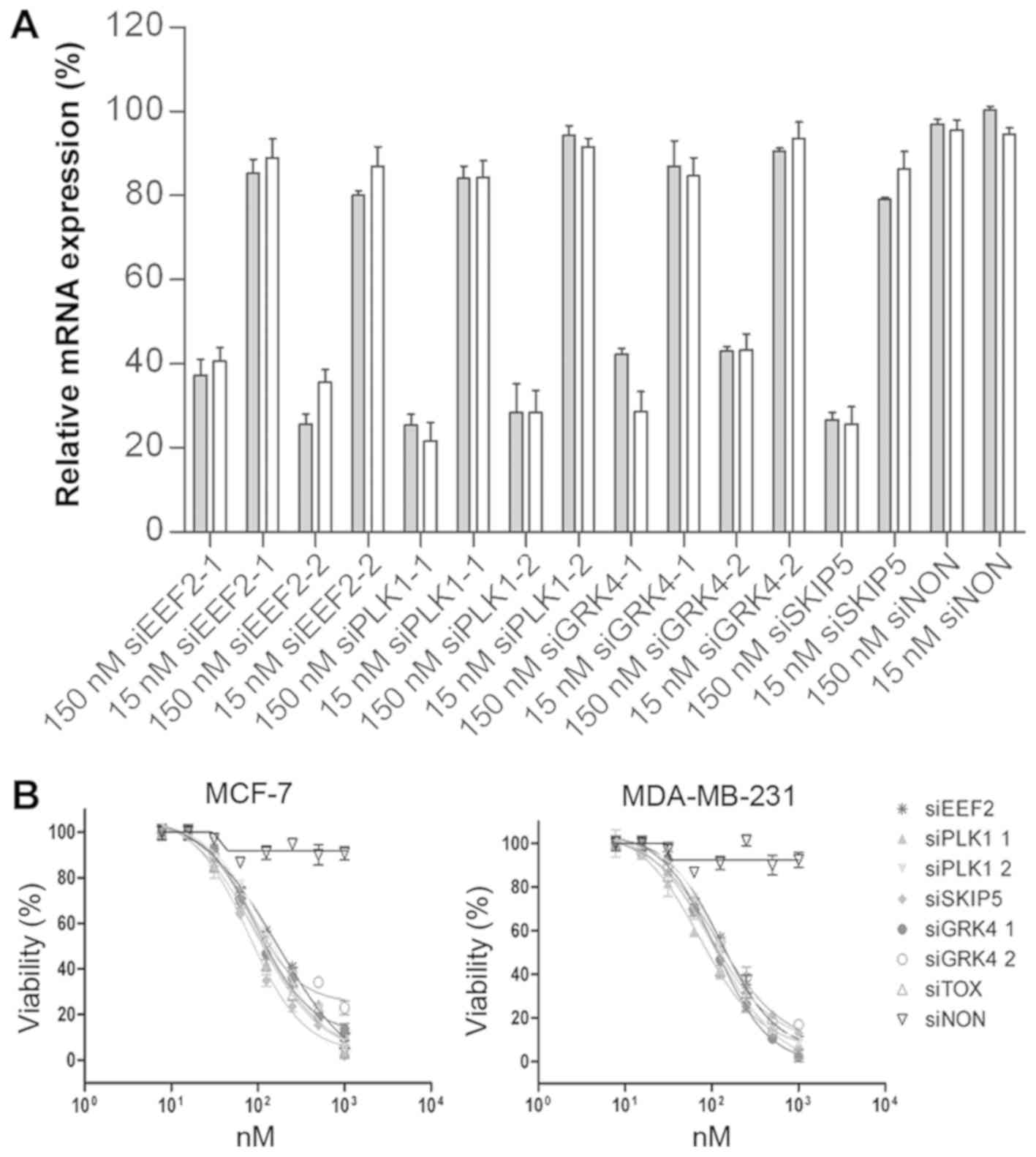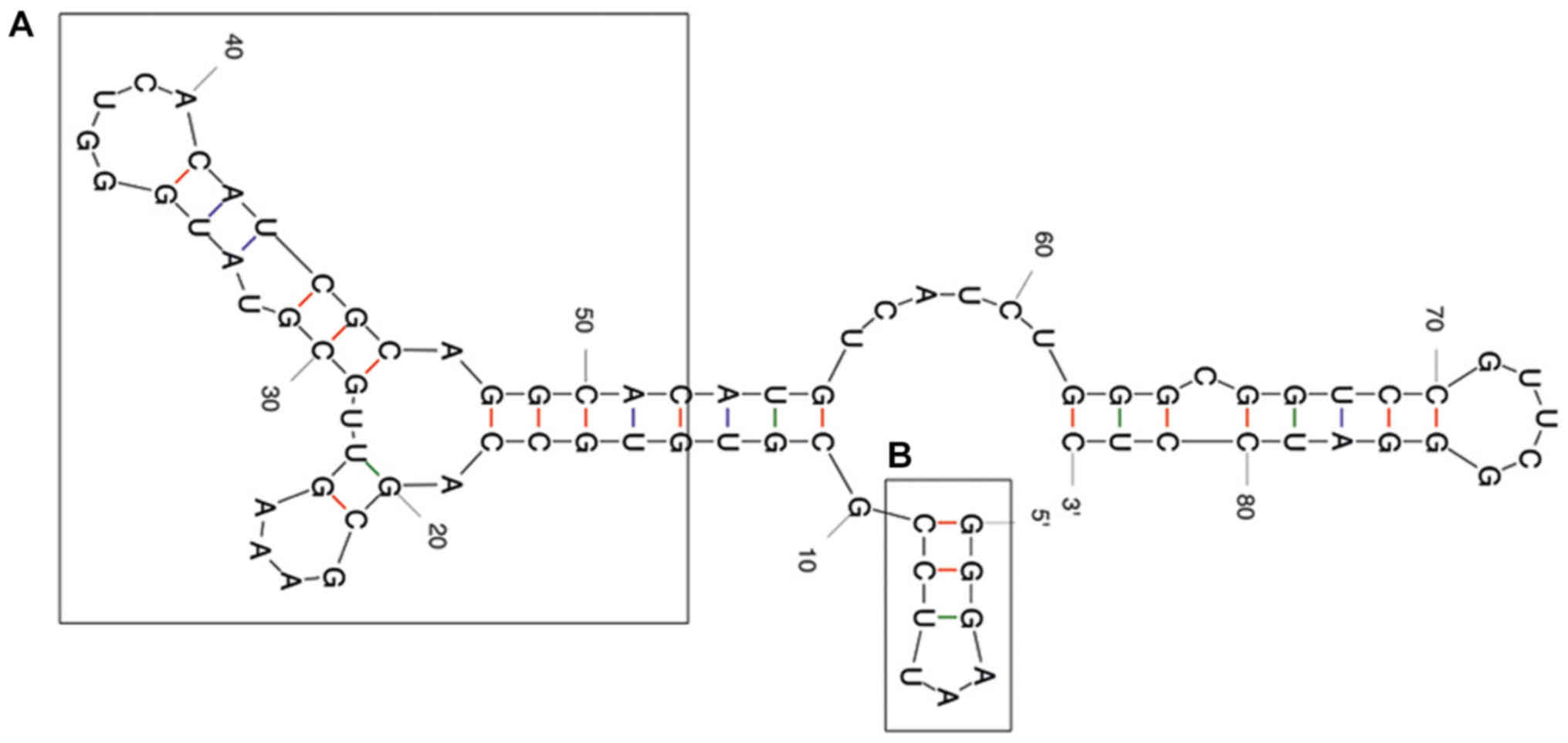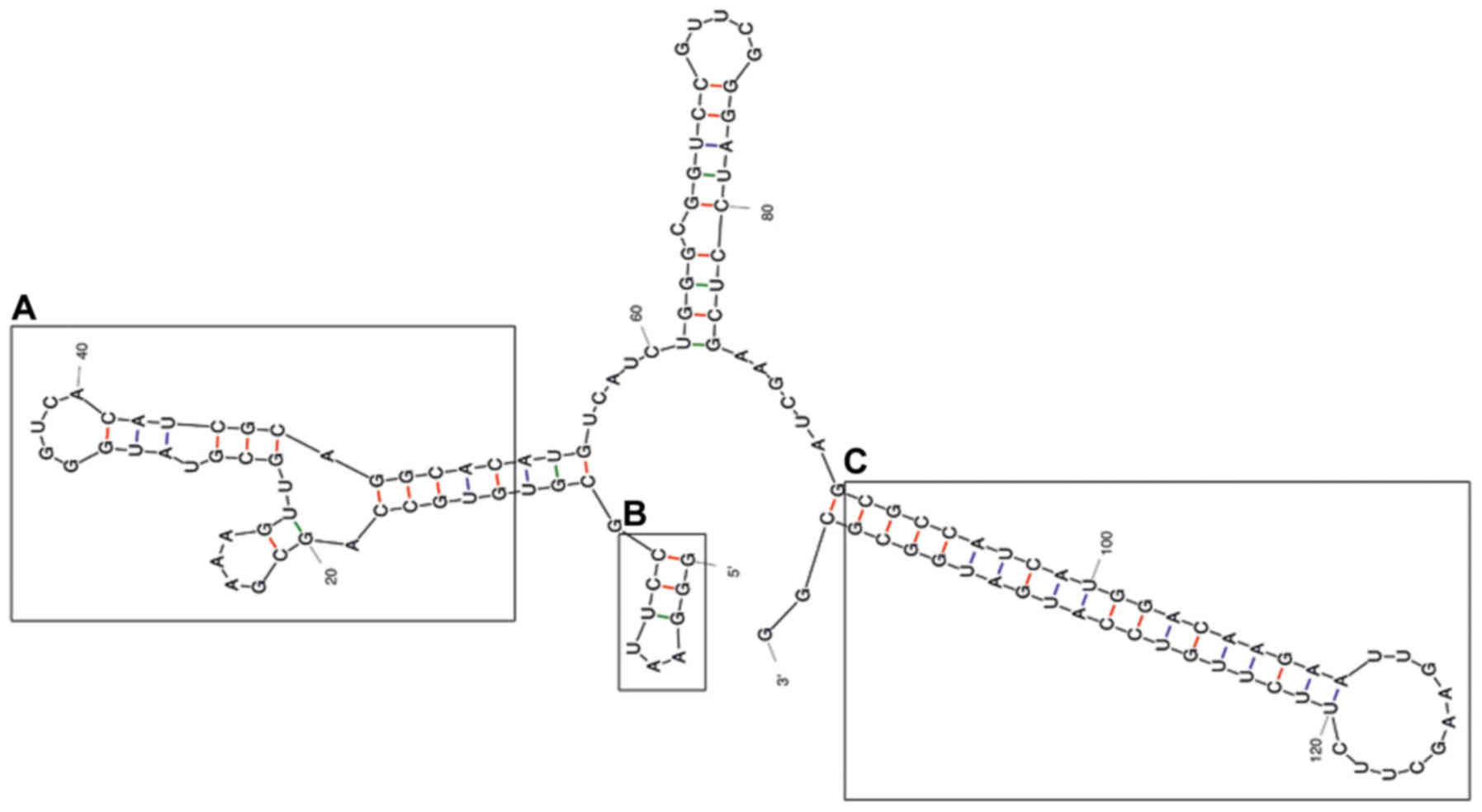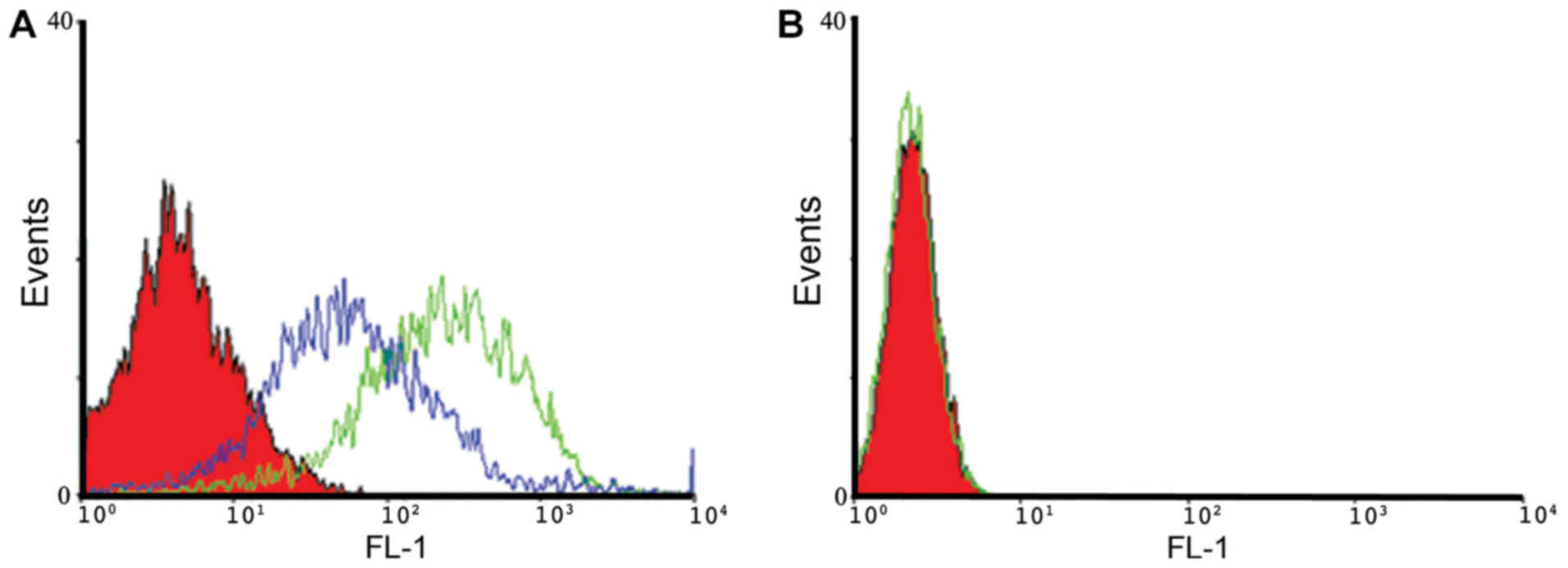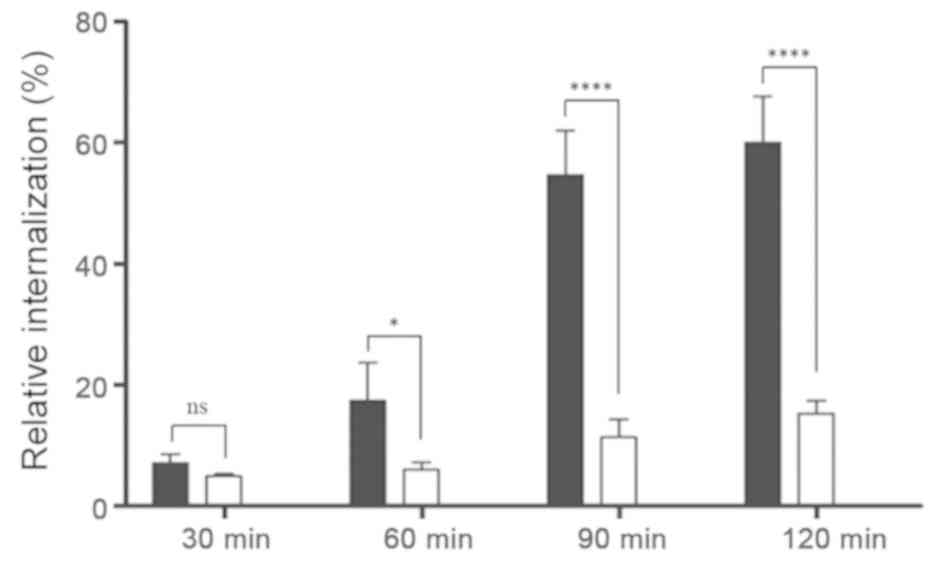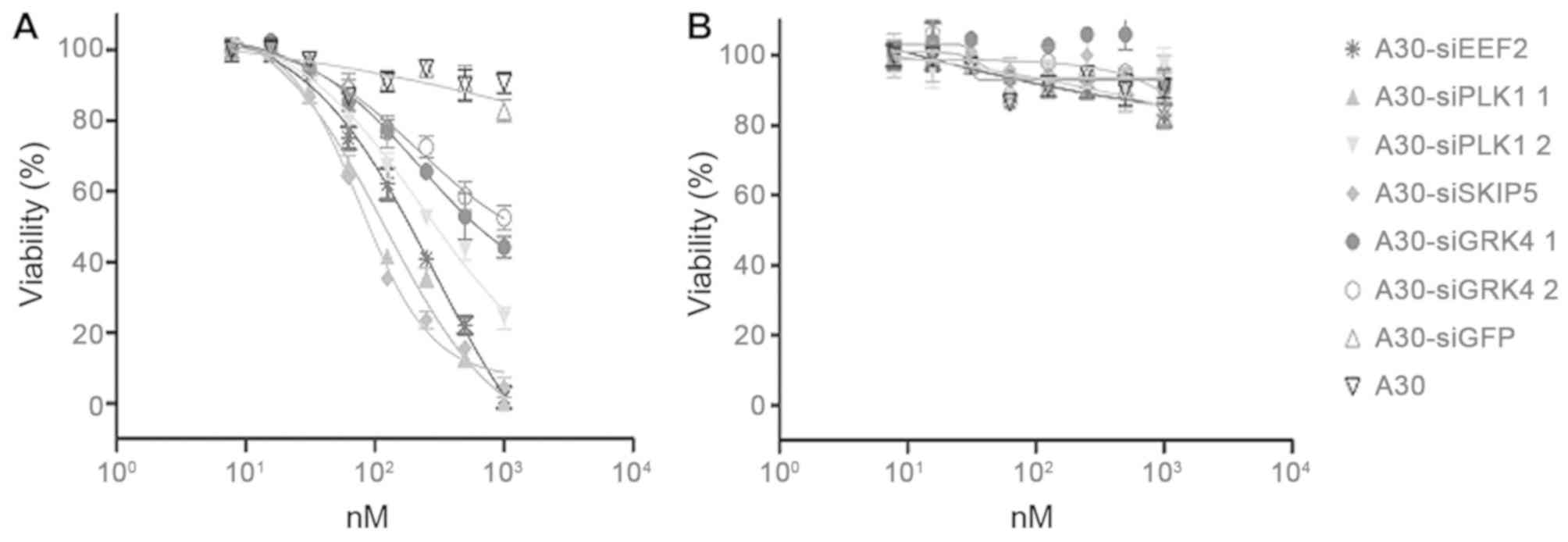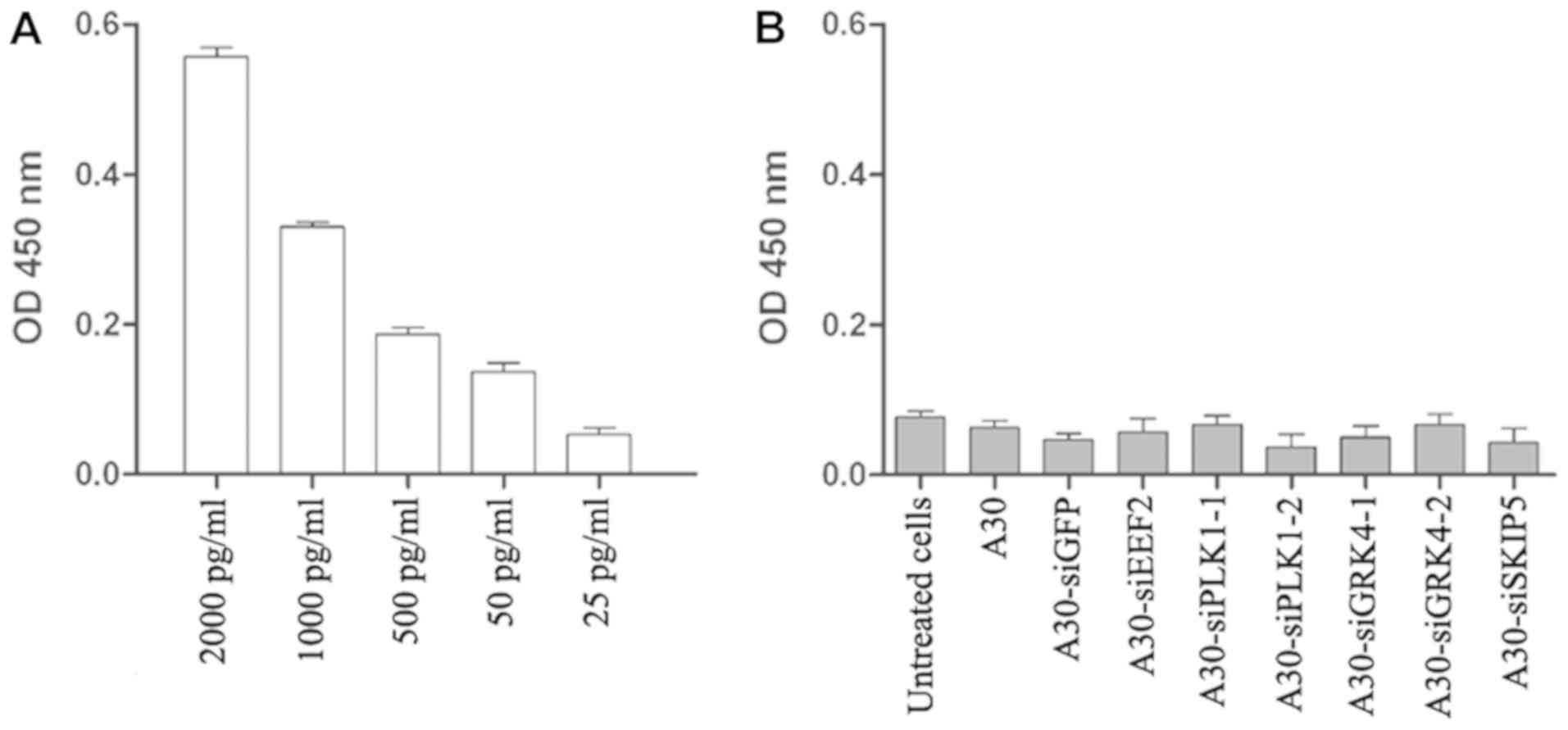|
1
|
Ferlay J, Soerjomataram I, Dikshit R, Eser
S, Mathers C, Rebelo M, Parkin DM, Forman D and Bray F: Cancer
incidence and mortality worldwide: Sources, methods and major
patterns in GLOBOCAN 2012. Int J Cancer. 136:E359–E386. 2015.
View Article : Google Scholar : PubMed/NCBI
|
|
2
|
Subik K, Lee JF, Baxter L, Strzepek T,
Costello D, Crowley P, Xing L, Hung MC, Bonfiglio T, Hicks DG, et
al: The expression patterns of ER, PR, HER2, CK5/6, EGFR, Ki-67 and
AR by immunohistochemical analysis in breast cancer cell lines.
Breast Cancer (Auckl). 4:35–41. 2010.PubMed/NCBI
|
|
3
|
Toss A and Cristofanilli M: Molecular
characterization and targeted therapeutic approaches in breast
cancer. Breast Cancer Res. 17:602015. View Article : Google Scholar : PubMed/NCBI
|
|
4
|
Schlotter CM, Vogt U, Allgayer H and
Brandt B: Molecular targeted therapies for breast cancer treatment.
Breast Cancer Res. 10:2112008. View
Article : Google Scholar : PubMed/NCBI
|
|
5
|
Guo W, Chen W, Yu W, Huang W and Deng W:
Small interfering RNA-based molecular therapy of cancers. Chin J
Cancer. 32:488–493. 2013. View Article : Google Scholar : PubMed/NCBI
|
|
6
|
Kim DH and Rossi JJ: Strategies for
silencing human disease using RNA interference. Nat Rev Genet.
8:173–184. 2007. View
Article : Google Scholar : PubMed/NCBI
|
|
7
|
Karagiannis TC and El-Osta A: RNA
interference and potential therapeutic applications of short
interfering RNAs. Cancer Gene Ther. 12:787–795. 2005. View Article : Google Scholar : PubMed/NCBI
|
|
8
|
Hristodorov D, Mladenov R, von Felbert V,
Huhn M, Fischer R, Barth S and Thepen T: Targeting CD64 mediates
elimination of M1 but not M2 macrophages in vitro and in
cutaneous inflammation in mice and patient biopsies. MAbs.
7:853–862. 2015. View Article : Google Scholar : PubMed/NCBI
|
|
9
|
Maire V, Némati F, Richardson M,
Vincent-Salomon A, Tesson B, Rigaill G, Gravier E, Marty-Prouvost
B, De Koning L, Lang G, et al: Polo-like kinase 1: A potential
therapeutic option in combination with conventional chemotherapy
for the management of patients with triple-negative breast cancer.
Cancer Res. 73:813–823. 2013. View Article : Google Scholar : PubMed/NCBI
|
|
10
|
King SI, Purdie CA, Bray SE, Quinlan PR,
Jordan LB, Thompson AM and Meek DW: Immunohistochemical detection
of Polo-like kinase-1 (PLK1) in primary breast cancer is associated
with TP53 mutation and poor clinical outcom. Breast Cancer Res.
14:R402012. View
Article : Google Scholar : PubMed/NCBI
|
|
11
|
Lens SM, Voest EE and Medema RH: Shared
and separate functions of polo-like kinases and aurora kinases in
cancer. Nat Rev Cancer. 10:825–841. 2010. View Article : Google Scholar : PubMed/NCBI
|
|
12
|
Keever LB, Jones JE and Andresen BT: G
protein-coupled receptor kinase 4gamma interacts with inactive
Galpha(s) and Galpha13. Biochem Biophys Res Commun. 367:649–655.
2008. View Article : Google Scholar : PubMed/NCBI
|
|
13
|
Strub GM, Maceyka M, Hait NC, Milstien S
and Spiegel S: Extracellular and intracellular actions of
sphingosine-1-phosphate. Adv Exp Med Biol. 688:141–155. 2010.
View Article : Google Scholar : PubMed/NCBI
|
|
14
|
Dominska M and Dykxhoorn DM: Breaking down
the barriers: siRNA delivery and endosome escape. J Cell Sci.
123:1183–1189. 2010. View Article : Google Scholar : PubMed/NCBI
|
|
15
|
Bartlett DW, Su H, Hildebrandt IJ, Weber
WA and Davis ME: Impact of tumor-specific targeting on the
biodistribution and efficacy of siRNA nanoparticles measured by
multimodality in vivo imaging. Proc Natl Acad Sci USA.
104:15549–15554. 2007. View Article : Google Scholar : PubMed/NCBI
|
|
16
|
Lakhin AV, Tarantul VZ and Gening LV:
Aptamers: Problems, solutions and prospects. Acta Naturae. 5:34–43.
2013. View Article : Google Scholar : PubMed/NCBI
|
|
17
|
Krause DS and Van Etten RA: Tyrosine
kinases as targets for cancer therapy. N Engl J Med. 353:172–187.
2005. View Article : Google Scholar : PubMed/NCBI
|
|
18
|
Chen CH, Chernis GA, Hoang VQ and Landgraf
R: Inhibition of heregulin signaling by an aptamer that
preferentially binds to the oligomeric form of human epidermal
growth factor receptor-3. Proc Natl Acad Sci USA. 100:9226–9231.
2003. View Article : Google Scholar : PubMed/NCBI
|
|
19
|
Carraway KL III, Sliwkowski MX, Akita R,
Platko JV, Guy PM, Nuijens A, Diamonti AJ, Vandlen RL, Cantley LC
and Cerione RA: The erbB3 gene product is a receptor for heregulin.
J Biol Chem. 269:14303–14306. 1994.PubMed/NCBI
|
|
20
|
Sliwkowski MX, Schaefer G, Akita RW,
Lofgren JA, Fitzpatrick VD, Nuijens A, Fendly BM, Cerione RA,
Vandlen RL and Carraway KL III: Coexpression of erbB2 and erbB3
proteins reconstitutes a high affinity receptor for heregulin. J
Biol Chem. 269:14661–14665. 1994.PubMed/NCBI
|
|
21
|
Kim S, Han J, Shin I, Kil WH, Lee JE and
Nam SJ: A functional comparison between the HER2(high)/HER3 and the
HER2(low)/HER3 dimers on heregulin-β1-induced MMP-1 and MMP-9
expression in breast cancer cells. Exp Mol Med. 44:473–482. 2012.
View Article : Google Scholar : PubMed/NCBI
|
|
22
|
Salameh A, Fan X, Choi BK, Zhang S, Zhang
N and An Z: HER3 and LINC00052 interplay promotes tumor growth in
breast cancer. Oncotarget. 8:6526–6539. 2017. View Article : Google Scholar : PubMed/NCBI
|
|
23
|
Suga J, Izumiyama K, Tanaka N and Saji S:
Estradiol promotes rapid degradation of HER3 in ER-positive breast
cancer cell line MCF-7. Biochem Biophys Rep. 16:103–109.
2018.PubMed/NCBI
|
|
24
|
Livak KJ and Schmittgen TD: Analysis of
relative gene expression data using real-time quantitative PCR and
the 2(-Delta Delta C(T)) Method. Methods. 25:402–408. 2001.
View Article : Google Scholar : PubMed/NCBI
|
|
25
|
Rydzanicz R, Zhao XS and Johnson PE:
Assembly PCR oligo maker: A tool for designing
oligodeoxynucleotides for constructing long DNA molecules for RNA
production. Nucleic Acids Res. 33(web server issue): W521–525.
2005.https://doi.org/10.1093/nar/gki380 View Article : Google Scholar : PubMed/NCBI
|
|
26
|
Fire A, Xu S, Montgomery MK, Kostas SA,
Driver SE and Mello CC: Potent and specific genetic interference by
double-stranded RNA in Caenorhabditis elegans. Nature. 391:806–811.
1998. View Article : Google Scholar : PubMed/NCBI
|
|
27
|
Whitehead KA, Langer R and Anderson DG:
Knocking down barriers: Advances in siRNA delivery. Nat Rev Drug
Discov. 8:129–138. 2009. View Article : Google Scholar : PubMed/NCBI
|
|
28
|
Hussain AF, Wullner U, Neef I, Tur MK and
Barth S.: Targeted delivery of short interfering RNAs - Strategies
for in vivo application. Topics in Anti-Cancer-Research.
Bentham Science Publishers. (Sharjah, U.A.E.). 228–253. 2013.
|
|
29
|
Martelotto LG, Ng CK, Piscuoglio S,
Weigelt B and Reis-Filho JS: Breast cancer intra-tumor
heterogeneity. Breast Cancer Res. 16:2102014. View Article : Google Scholar : PubMed/NCBI
|
|
30
|
Bu Y, Yang Z, Li Q and Song F: Silencing
of polo-like kinase (Plk) 1 via siRNA causes inhibition of growth
and induction of apoptosis in human esophageal cancer cells.
Oncology. 74:198–206. 2008. View Article : Google Scholar : PubMed/NCBI
|
|
31
|
Dassie JP, Liu XY, Thomas GS, Whitaker RM,
Thiel KW, Stockdale KR, Meyerholz DK, McCaffrey AP, McNamara JO II
and Giangrande PH: Systemic administration of optimized
aptamer-siRNA chimeras promotes regression of PSMA-expressing
tumors. Nat Biotechnol. 27:839–849. 2009. View Article : Google Scholar : PubMed/NCBI
|
|
32
|
McNamara JO II, Andrechek ER, Wang Y,
Viles KD, Rempel RE, Gilboa E, Sullenger BA and Giangrande PH: Cell
type-specific delivery of siRNAs with aptamer-siRNA chimeras. Nat
Biotechnol. 24:1005–1015. 2006. View Article : Google Scholar : PubMed/NCBI
|
|
33
|
Wullner U, Neef I, Eller A, Kleines M, Tur
MK and Barth S: Cell-specific induction of apoptosis by rationally
designed bivalent aptamer-siRNA transcripts silencing eukaryotic
elongation factor 2. Curr Cancer Drug Targets. 8:554–565. 2008.
View Article : Google Scholar : PubMed/NCBI
|
|
34
|
Machuy N, Thiede B, Rajalingam K, Dimmler
C, Thieck O, Meyer TF and Rudel T: A global approach combining
proteome analysis and phenotypic screening with RNA interference
yields novel apoptosis regulators. Mol Cell Proteomics. 4:44–55.
2005. View Article : Google Scholar : PubMed/NCBI
|
|
35
|
Zhang Y, Wang Y, Wan Z, Liu S, Cao Y and
Zeng Z: Sphingosine kinase 1 and cancer: A systematic review and
meta-analysis. PLoS One. 9:e903622014. View Article : Google Scholar : PubMed/NCBI
|
|
36
|
Xu Y, Dong B, Huang J, Kong W, Xue W, Zhu
Y, Zhang J and Huang Y: Sphingosine kinase 1 is overexpressed and
promotes adrenocortical carcinoma progression. Oncotarget.
7:3233–3244. 2016.PubMed/NCBI
|
|
37
|
Hussain AF, Tur MK and Barth S: An
aptamer-siRNA chimera silences the eukaryotic elongation factor 2
gene and induces apoptosis in cancers expressing αvβ3 integrin.
Nucleic Acid Ther. 23:203–212. 2013. View Article : Google Scholar : PubMed/NCBI
|
|
38
|
Li TS, Yawata T and Honke K: Efficient
siRNA delivery and tumor accumulation mediated by ionically
cross-linked folic acid-poly(ethylene glycol)-chitosan
oligosaccharide lactate nanoparticles: For the potential targeted
ovarian cancer gene therapy. Eur J Pharm Sci. 52:48–61. 2014.
View Article : Google Scholar : PubMed/NCBI
|
|
39
|
Song E, Zhu P, Lee SK, Chowdhury D,
Kussman S, Dykxhoorn DM, Feng Y, Palliser D, Weiner DB, Shankar P,
et al: Antibody mediated in vivo delivery of small
interfering RNAs via cell-surface receptors. Nat Biotechnol.
23:709–717. 2005. View Article : Google Scholar : PubMed/NCBI
|
|
40
|
Reschke M, Mihic-Probst D, van der Horst
EH, Knyazev P, Wild PJ, Hutterer M, Meyer S, Dummer R, Moch H and
Ullrich A: HER3 is a determinant for poor prognosis in melanoma.
Clin Cancer Res. 14:5188–5197. 2008. View Article : Google Scholar : PubMed/NCBI
|
|
41
|
Servidei T, Riccardi A, Mozzetti S,
Ferlini C and Riccardi R: Chemoresistant tumor cell lines display
altered epidermal growth factor receptor and HER3 signaling and
enhanced sensitivity to gefitinib. Int J Cancer. 123:2939–2949.
2008. View Article : Google Scholar : PubMed/NCBI
|
|
42
|
Lee-Hoeflich ST, Crocker L, Yao E, Pham T,
Munroe X, Hoeflich KP, Sliwkowski MX and Stern HM: A central role
for HER3 in HER2-amplified breast cancer: Implications for targeted
therapy. Cancer Res. 68:5878–5887. 2008. View Article : Google Scholar : PubMed/NCBI
|
|
43
|
Jeschke M, Wels W, Dengler W, Imber R,
Stöcklin E and Groner B: Targeted inhibition of tumor-cell growth
by recombinant heregulin-toxin fusion proteins. Int J Cancer.
60:730–739. 1995. View Article : Google Scholar : PubMed/NCBI
|
|
44
|
Yu X, Ghamande S, Liu H, Xue L, Zhao S,
Tan W, Zhao L, Tang SC, Wu D, Korkaya H, et al: Targeting
EGFR/HER2/HER3 with a three-in-one aptamer-siRNA chimera confers
superior activity against HER2+ breast cancer. Mol Ther
Nucleic. 10:317–330. 2018. View Article : Google Scholar
|















